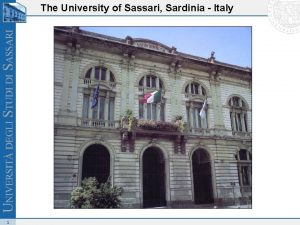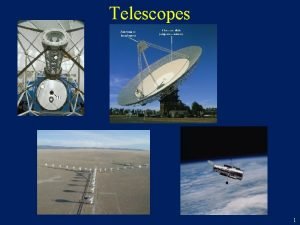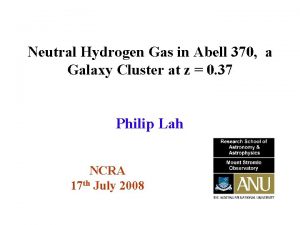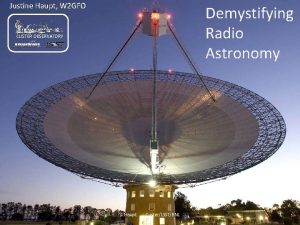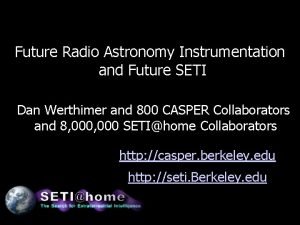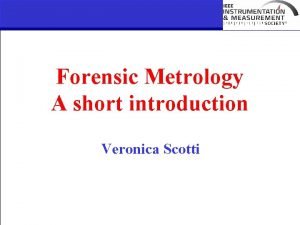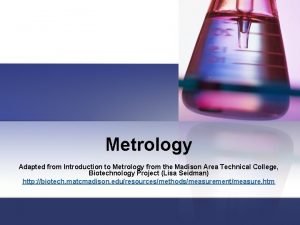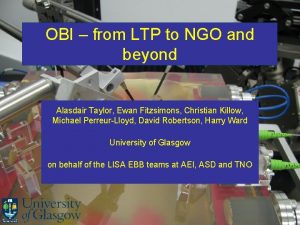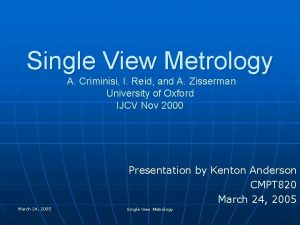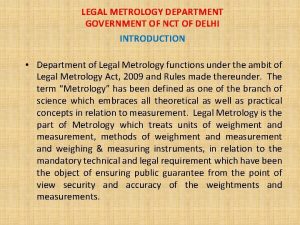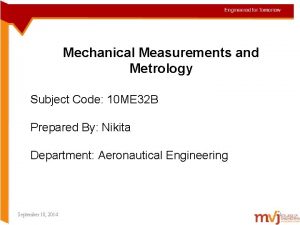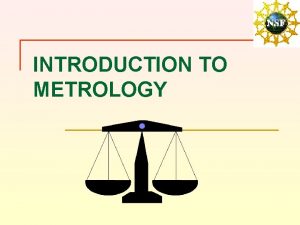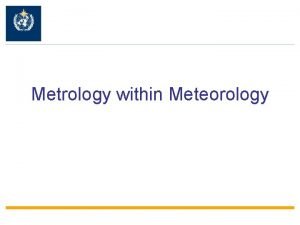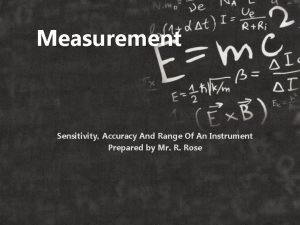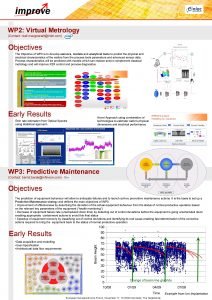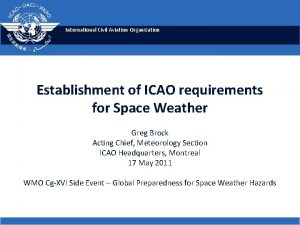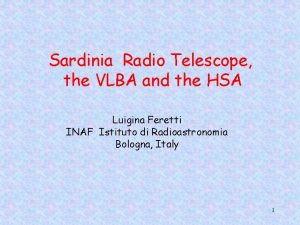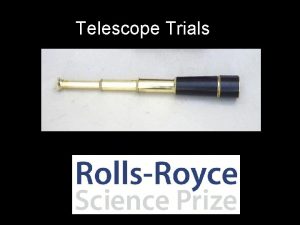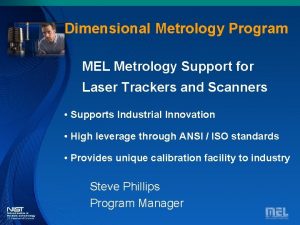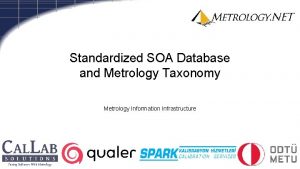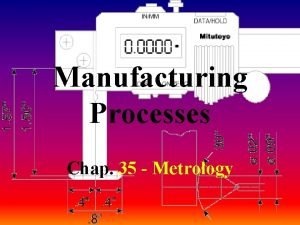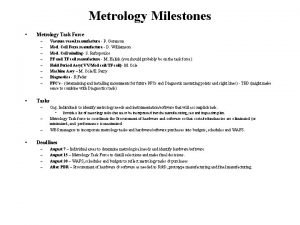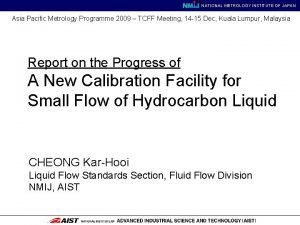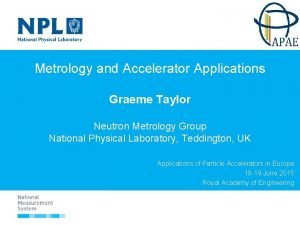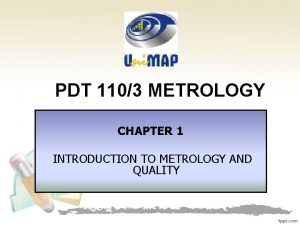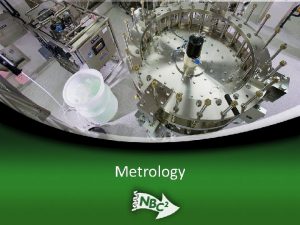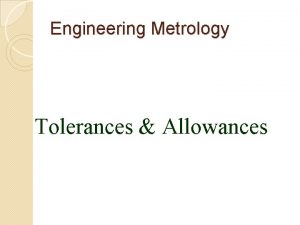Metrology at the Sardinia Radio Telescope T Pisanu






















- Slides: 22

Metrology at the Sardinia Radio Telescope T. Pisanu tpisanu@oa-cagliari. inaf. it on behalf of Metrology team* *G. Serra, S. Poppi, F. Buffa, P. Marongiu, R. Concu, G. Vargiu, P. Ortu, A. Saba, E. Urru, G. Deiana Astronomical Observatory of Cagliari Italian National Institute for Astrophysics Astronomical Observatory of Cagliari Sardinia Radio Telescope Metrology and Control of Large Telescopes Green Bank WV, USA, September 19 -24, 2016

Agenda � SRT main characteristics description � SRT status at the end of the astronomical validation � Work progress status of the first SRT metrology systems: ◦ With-phase microwave holography ◦ Inclinometers ◦ Temperature probes ◦ Optical laser and Position sensing devices (PSD) � Conclusions Metrology at Sardinia Radio Telescope

SRT Project September 30 th 2013, 0. 3 -115 SRT opening 64 m diameter fully steerable radiotelescope to cover GHz: - cerimony, 2014 end of the scientific Single dish operation commissioning and on 2016 started the earlynetwork science. On 2017 we need to Part of VLBI and EPTA the antenna operation to start Space science and stop geodynamical studies with the refurbishment of the primary reflector actuators. Collaboration among three Research Structures of INAF: • INAF Astronomical Observatory of Cagliari, Cagliari • INAF Institute of Radio Astronomy, Bologna • INAF Arcetri Astrophysical Observatory, Florence Cost 60 MEuro Main Funding Institutions: • MIUR (Italian Ministry of Education and Scientific Research) • ASI (Italian Space Agency) • RAS (Sardinia Regional Government) Metrology at Sardinia Radio Telescope

SRT technical specifications Gregorian Configuration with shaped surfaces Primary Mirror D=64 m – 1008 panels - 65 m ; Secondary Mirror D=7. 9 m – 49 panels - 50 m Active Surface: Primary mirror adjustable with 1116 actuators 12 motors (eight in azimuth and four in elevation) 29 bit absolute encoders (error 0, 8 arcsec); Six focal positions Can host up to 20 dual polarization receivers; ACU based on a BECKHOFF hardware Primary surf. Accuracy goal: 150 m RMS Pointing accuracy goal (RMS): 2 ÷ 5 arcsec Max antenna efficiency goal: 60 % Gain exp. 0. 50 to 0. 70 K/Jy @ 0. 3– 50 GHz and 0. 34 K/Jy @ (70– 115 GHz). Frequency agility Metrology at Sardinia Radio Telescope

SRT status: installed receivers F/D =2. 35 7. 5 GHz < f < 115 GHz 0. 305 -0. 410 /1. 3 -1. 8 GHz K-band receiver P/L-band receiver 18 -26, 5 GHz F/D =0. 33 300 MHz < f < 20 GHz 5. 7 -7. 7 GHz C-band receiver Gregorian Focus BWG foci BWG F/D =1. 37 & 2. 81 1. 4 GHz < f < 35 GHz S-band (3 -4. 5 GHz) and Q-band (33 -50 GHz) multifeed receivers founded and in developement. A 100 GHz receiver got from IRAM and an X-Ka band Metrology at Sardinia Radio Telescope

Active surface: shape of primary mirror controlled with actuators v Compensate deformations of the primary mirror v Convert shaped profile to a true-parabola (for primary focus) Metrology at Sardinia Radio Telescope

Actuators problem: Corrosion phenomena The problem with the actuators was due to two concurring negative phenomena, like strain-induced-corrosion and galvanic currents. The coupling of two alloys, like steel and ERGAL contributed to increase those two phenomena, creating cracks in the ERGAL part and compromising the actuators integrity. Al. Zn 10 Si 8 Mg UNI EN 1676 1706 ERGAL 55 UNI 9007/2 T 6 7075 T 6 AISI 304 L UNI X 2 Cr. Ni 1811 Metrology at Sardinia Radio Telescope

Metrology at Sardinia Radio Telescope

SRT status: surface accuracy After the first panels alignment of the secondary and primary mirror with fotogrammetric measurement (by SIGMA 3 D) AICON DPA mit Nikon D 3 X, 24. 5 MPixel (6048 x 4032) 2 Scale bars, Trafo. Star Subreflector surface Accuracy: ~ 60 μm RMS @ 45° elevation Primary reflector surface Accuracy: ~ 290 μm RMS @ 45° elevation Accuracy in the adjacent panels corner alignment better than 100 μm Overall RMS accuracy of the reflecting surfaces ε~ 310 μm (= λ/20 @ ~ 48 GHz) Very good surface efficiency up to 48 GHz Metrology at Sardinia Radio Telescope

Primary mirror Fotogrammetry results Metrology at Sardinia Radio Telescope

SRT status: antenna performances Top: Elevation-averaged beam patterns (in Jy/beam) of 20 OTF scans Bottom: Beam cross-sections along the Azimuth and Elevation axes (in d. B). Calibrator 3 C 147 @ 7, 24 GHz Calibrator 3 C 84 @ 25, 54 GHz Fitting a Gaussian we can find the secondary lobe intensity averaged over an annulus of 4. 5’ radius and 3’ width is -24 d. B and the third lobe is – 33 d. B in which it is possible to see the effect of the trusses of the quadripod but for the K band the secondary lobe is -12 d. B so not in specific Courtesty of SRT Astronomical Validation (Prandoni et al. in preparation) Metrology at Sardinia Radio Telescope

SRT status: antenna performances Map dimension 6’ x 6’ Maps of Contour levels start at -25 d. B and increase by 1 d. B. HPBW 2. 6 arcmin The secondary lobe moves from the upper part to the lower moving from the 60° EL Courtesty of SRT Astronomical Validation (Prandoni et al. in preparation) Metrology at Sardinia Radio Telescope

SRT status: antenna performances After the fine tuning of the telescope with active surfaces working, the pointing model allows SRT to observe at 22 GHz with a: � � focusing accuracy < 1 mm an azimuth and elevation pointing errors < 4 arc sec Courtesty of SRT Astronomical Validation (Prandoni et al. in preparation) Metrology at Sardinia Radio Telescope

SRT metrology short-term goals Waiting for the higher frequency receivers, the metrology team is working to further improve the current SRT efficiency � Short-term goals: ◦ To measure the primary surface accuracy better than 150 µm (i. e. an overall surface accuracy 190 µm, a very good efficiency up to ~80 GHz ) with Microwave holography system to measure RT far-field pattern by pointing a Ku-band GEO satellite (elevation angle 44 deg ); ◦ To contribute to correct azimuth and elevation pointing errors < HPBW/10 ( ~ 1 arcsec with HPBW =12 arcsec @ 100 GHz ) with two inclinometers on top of the alidade structure; ◦ Temperature sensors for reducing detrimental thermal gradient effects on the pointing errors; ◦ To correct pointing errors and focusing accuracy < λ/10 (~0. 3 mm @ 100 GHz ) with optical laser-PSDs behind the subreflector central panel; Metrology at Sardinia Radio Telescope

Status of holography system New measurement set-up for SRT holography system RT front-end modified LNB on the primary focus Apex balcony Reference front-end 0. 6 m-diameter antenna and modified LNB RF equipment for injecting the 10 GHz LO signal to LNBs at the apex room RF electronics rack at EER (where IF-BOX and digital backend will be soon installed) Installation completed by 2014 and few months ago we started the first holography campaign at SRT Metrology at Sardinia Radio Telescope

Status of Inclinometer On the base of the recommendations coming from the SRT thermal design study Inclinometer #1 Inclinometer #2 (not installed yet) RS 485 -LAN converter Inclinometer control PC Metrology at Sardinia Radio Telescope

Status of inclinometer Tests to check the planarity of the azimuth rail Elevation axis errors measured during a full rotation in azimuth Cross-elevation axis errors during a full rotation in azimuth Systematic errors not far from the expected one (± 3 arcsec) deriving from the rail planarity tolerance. However they can be included in the antenna pointing model Metrology at Sardinia Radio Telescope

Work progress status of inclinometer Inclinometer measurement during astronomical observation on a circumpolar radio source at 23 GHz (K-band receiver) from sunrise to noon. Elevation axis errors caused by antenna thermal deformations + residual offset - inclinometer meas Residual offsets calculated from a Gaussian fit of the antenna beam after a cross-scan. Azimuth axis errors caused by antenna thermal deformations Kalman filter was used to remove the noisy high frequency components due to antenna acceleration. + residual offset - inclinometer meas NOTE. With the antenna pointing model working, residual offsets take into account both alidade and quadripod temperature variation (not only alidade as in the inclinometer measurement) Metrology at Sardinia Radio Telescope

Status of temperature probes The number and position of the temperature probes on SRT structure were inferred by FEM model: • 16 probes on the alidade • 8 probes on the quadrupod Probes installation, cabling and interfacing with Beckhoff embeddes PC will be soon accomplished Metrology at Sardinia Radio Telescope

Status of optical laser PSD Two PSD for a real-time measurement of the secondary mirror misalignments, one is already installed behind the central panel of the sub-reflector and we are testing its performances PSDs Laser diodes y x z Wavelength = 658 nm Power = 10 m. W 23 m Sensitive area = 22. 5 x 22. 5 mm^2 Operational spectral range : 350 -1100 nm power range: 0. 1 -5 m. W Accuracy over calibrate area= ± 50 µm Angular measur. range = ± 2 deg Angular resolution = ± 1 arcsec PSDs can measure X, Y, Z translation (derived by two X measur. ) and X, Y axes rotation of the subreflector. Only one at the moment is installed. Metrology at Sardinia Radio Telescope

SRT metrology future plans � � � Include inclinometer, PSD and temperature probe data in the antenna pointing model in order to reduce the errors and to try to compensate for alidade and quadrupod thermal deformations Beside the traditional holography, we plan to use the Out-of-Focus method on SRT for a quasi-real time mapping of the primary surface deformations, due even to thermal gradients effects and the linear sensors New systems: Laser Tracker and Real Time photogrammetry Metrology at Sardinia Radio Telescope

Conclusions � � Many thanks to Richard for his efforts in organizing this workshop; I think that if we could have this workshop few years ago we could be in a better condition in the development of an efficient and well organized Metrology plan for SRT. Thanks for your attention! Any questions? Metrology at Sardinia Radio Telescope
 Is molas golf resort
Is molas golf resort Universities in sardinia
Universities in sardinia Structure of radio telescope
Structure of radio telescope Radio telescope
Radio telescope Anu
Anu Justine haupt
Justine haupt Radio telescope
Radio telescope Awin support
Awin support Forensic metrology
Forensic metrology Introduction of metrology
Introduction of metrology Ebbing metrology
Ebbing metrology Single view metrology
Single view metrology Dubai meteorological office
Dubai meteorological office Selective assembly in metrology
Selective assembly in metrology Legal metrology officer
Legal metrology officer Metrology and measurements subject code
Metrology and measurements subject code What is software measurement
What is software measurement Introduction to metrology
Introduction to metrology Bipm metrology
Bipm metrology Saudi standards, metrology and quality organization
Saudi standards, metrology and quality organization Define sensitivity in metrology
Define sensitivity in metrology Virtual metrology
Virtual metrology International metrology organization headquarters
International metrology organization headquarters

